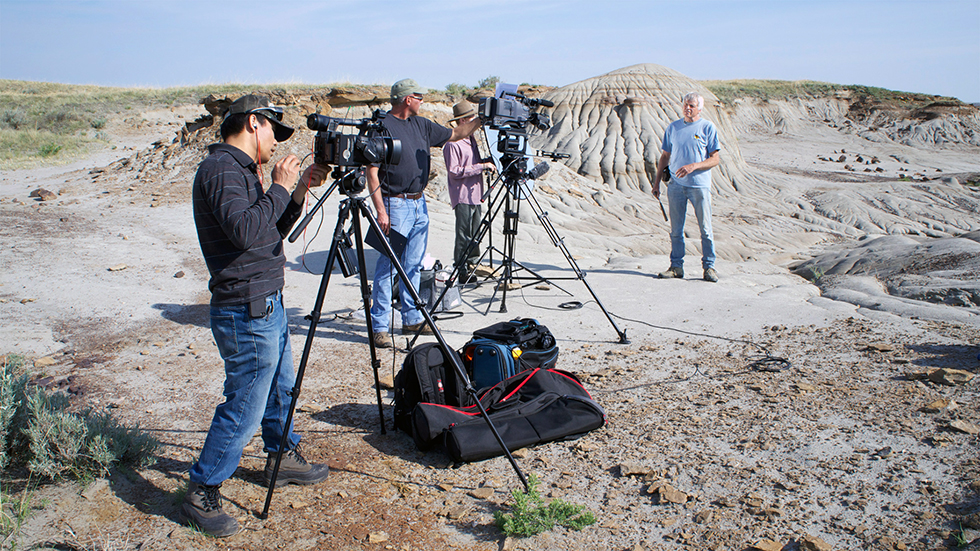
Dino 101: Dinosaur Paleobiology
Dino 101: Dinosaur Paleobiology teaches a comprehensive overview of non-avian dinosaurs. Lessons are delivered from museums, fossil-preparation labs and dig sites.
Take online for free
Sign up for free on Coursera today or upgrade to get a certificate.
Take for credit
U of A students can sign up for PALEO 200/201 (3 credits) and access the course through eClass. Find full registration instructions here.
About the Course
Dino 101: Dinosaur Paleobiology is a 12-lesson course teaching a comprehensive overview of non-avian dinosaurs.
Topics covered:
- anatomy
- eating
- locomotion
- growth
- environmental and behavioural adaptations
- origins and extinction.
Dino 101 will not only be engaging for individuals, but also for families and community members to share in the learning experience of the scientific method through the inspirational world of dinosaurs. It will also help highlight the best of Alberta's rich dinosaur assets.
What is the coolest thing you'll learn if you take this class? In addition to learning about dinosaurs, you will learn about how they lived, what they ate, how they fought, about their origins and extinction.
Course Preview
See first-hand some of the cool interactive learning pieces in the course, including:
- Navigate the Geologic Time Scale
- Put Together a Tyrannosaurus Skeleton
- Label a Phylogenic Tree
UAlberta's Dino 101 is the world's first paleobiology Massive Open Online Course (MOOC) and Canada's first Massive Open Online Course (MOOC) available for credit to University of Alberta students. UAlberta is drawing on the reputational strengths of our world class paleontology team and our researchers working with our Canada Research Chair in Educational Measurement.
Alignment with Alberta Curriculum
Taking the course as an Alberta junior high or high school student? Dino 101 content aligns with parts of the Alberta curriculum for Science 7 and 20 and Bio 20. Learn how U of A MOOCs align with Alberta's secondary curricula.
Course Format
The class will consist of lecture videos interposed with integrated quiz questions in addition to a unit test after each of the 12 lessons. Students taking the course for credit at the University of Alberta will be required to take a midterm and final exam as well.
Time Commitment: 3-10 hours/week
Suggested readings:
Although the lectures are designed to be self-contained, there are many good books available on dinosaurs. Recent books we can recommend for the interested students include:
- The Complete Dinosaur, 2nd edition, (edited by Brett-Surman, Holtz and Farlow), Indiana University Press.
- Dinosaur Paleobiology (by S. Brusatte), Wiley Blackwell.
Required resources:
An internet connection and a sense of adventure.
Recommended background:
No background is required; all are welcome!
Take the course for free & engage with the inspirational world of dinosaurs
Instructors
Philip John Currie, PhD, Professor and Canada Research Chair
Department of Biological Sciences, University of Alberta
Dino 101 is led by Dr. Phil Currie, Curator of Dinosaurs at the University of Alberta Laboratory for Vertebrate Paleontology, Canada Research Chair in Dinosaur Paleobiology, Fellow of the Royal Society of Canada, recipient of the prestigious Explorer’s club medal, and Roy Chapman Andrews Society Distinguished Explorer Medal (2022).
Dr. Currie is an internationally renowned palaeontologist whose scientific accomplishments have led to a greater understanding of dinosaurs and their historic significance. He was instrumental in the development of Alberta's Royal Tyrrell Museum and has made major contributions to palaeontology on both the Canadian and the world stage through his extensive field work, academic research, writing and teaching.
Angelica Torices, Postdoctoral Researcher
Department of Biological Sciences, University of Alberta
Angelica is from Spain and has dedicated much of her research to theropod teeth and dinosaur trackways. At the Complutense University of Madrid, she received a degree in Geology with specialization in paleontology, followed by a MSc in 2002 and PhD in Paleontology in 2007. Some of this doctoral research was conducted in conjunction with the Currie Lab and, in 2011, Angelica became a postdoctoral researcher at the University of Alberta.
» Learn more here about the crew behind Dino 101.
Syllabus
Module 1 - Appearances and Anatomy
Covers the diversity in dinosaur appearances, and will be able to identify major features of the major groups of dinosaurs.
Module 2 - Death and Fossilization
Describes how fossils form, how we interpret the taphonomy of skeletons and bonebeds, and looks at the possible biases taphonomic events may create in the fossil record.
Module 3 - Eating
Looks at the variety of food types, feeding habits, and feeding adaptations amongst the major groups of dinosaurs
Module 4 - Moving Around
Helps students understand the general modes and styles of locomotion in the major dinosaur groups. The lesson also describes general methods of evaluating hypotheses on locomotion.
Module 5 - Birth, Growth, Reproduction
Provides a generalized life history of a dinosaur, from birth through adulthood, including reproduction. The student will be able to describe major techniques of evaluating growth stages and rates in dinosaurs.
Module 6 - Attack and Defence
Examines the behaviours and structures that may have served for attack or defence through the lifetime of a dinosaur.
Module 7 - What is a Species
Teaches the different ways of defining what a species is. Students will be able to compare the strengths and weaknesses of different species concepts for different situations.
Module 8 - Evolution
Describes the basic theories of speciation, and discusses how how these different methods of speciation may have occurred, including both hypothetical and empirical examples.
Module 9 - Stratigraphy and Geologic Time
Provides basic stratigraphic concepts and the scale of earth history. Students will understand the evolution of dinosaurs through time, including which groups evolved when and where.
Module 10 - Palaeogeography and Plate Tectonics
Presents the basic concepts in plate tectonics and the evolution of the earth's surface.
Module 11 - Dinosaur Origins
Looks at the evolution of dinosaurs from non-dinosaurian archosaurs.
Module 12 - Dinosaur Extinction
Examines the end-Cretaceous extinction event and provides examples of vertebrate groups that both persisted and died out during the event.
